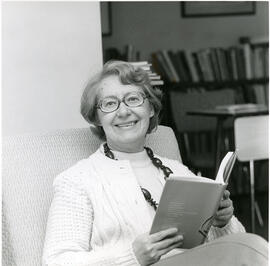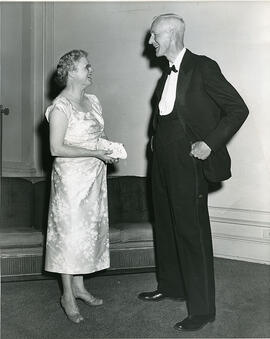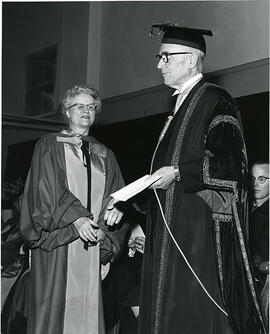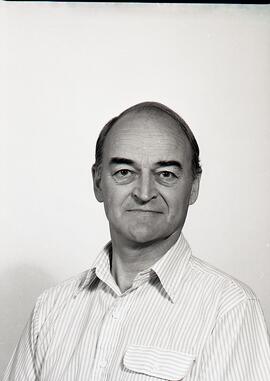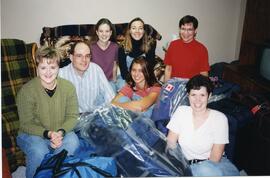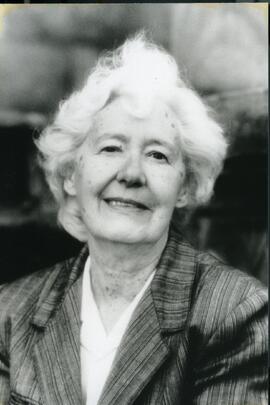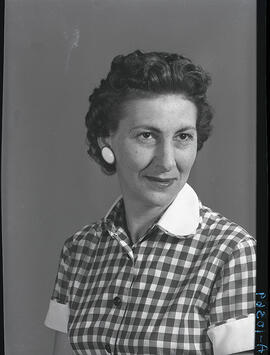Cavendish Physics Research - Group Photo
- B-585
- Stuk
- 1928
Image of members of the Cavendish Research group, Cambridge University. Dr. E.L. Harrington of Physics (third row, fourth from right) among the people identified, including two women, Gladys Isabel Harper (née Mackenzie), and Esther "Polly" Salaman (née Polianowsky).
Bio/Historical Note: Gladys Isabel Mackenzie was born 2 May 1903 in Edinburgh, Scotland. She attended Craigmount School, Edinburgh, from 1913-1919. In 1919 Mackenzie matriculated in the Faculty of Arts at the University of Edinburgh. She graduated with an MA with first class honours in Mathematics and Natural Philosophy in 1924. She was also awarded a BSc from [Edinburgh]. Mackenzie was appointed as an assistant in the Department of Natural Philosophy in the University of Edinburgh. She worked with Charles Glover Barkla, professor of Natural Philosophy, and wrote two joint papers with him both published in the Philosophical Magazine: Notes on the superposition of x-rays and on scattering: the J phenomenon (Part III) (February 1926) and Notes on scattered x-rays: the J phenomenon (Part V) (November 1926). After working in Edinburgh for two years, Mackenzie was appointed to a lectureship in Physics at Newnham College, Cambridge in August 1926. Mackenzie joined the Edinburgh Mathematical Society in March 1925. She continued her membership when she went to Newnham College, Cambridge but she left the Society in 1930. On 14 March 1929 Mackenzie married Wallace Russell Harper, PhD, who was also a physicist; they had one son. In 1930 the Newnham College Roll letter (reporting for 1929) stated “Mrs W R Harper (Miss G I Mackenzie), who had been lecturer in Physics since 1926, resigned her post this year, and the Council appointed Miss A C Davies (D.Sc. Lond.) to succeed her”. Gladys Harper, now her married name, was a Bristol University Carnegie Research Scholar in 1929-30, then a research fellow from 1930 to 1933. From the beginning of her time at Bristol in 1929 to her resignation in 1947, Harper conducted her most noteworthy research. She started by researching methods of measuring the ranges of alpha particles. She tested ranges of alpha particles at varying initial velocities as they travelled through gases such as air, oxygen, nitrogen, argon and hydrogen and observed the stopping power of these gases as the particles travelled through them. Harper discovered a relationship between the range of the alpha particles and its initial velocity and proved that the theory of Gaunt for the stopping power of hydrogen atoms is also applicable for molecular hydrogen. This research was published in 1930. She was employed part-time at Bristol University to undertake both teaching and research from 1933 to 1939, then she was appointed as a lecturer in the Department of Physics, a position she held until 1947. In 1952 Harper was appointed as a part-time teacher at Channing School in Highgate, London. She taught there until 1958 when she became a part-time lecturer in Physics at Queen Elizabeth College, London. She continued in this position until she retired in 1970, the year her husband died, when she was made an honourary lecturer of the college. Gladys Harper died 22 February 1989 in North York, Ontario.
Bio/Historical Note: Esther (Polly) Polianowsky was born 6 January 1900 in Zhytomyr, Russian Empire. In 1917 she was accepted to the Kiev University to study mathematics. As civil war and anti-Semitic pogroms spread across the Russian Empire, however, her father forbade her from leaving alone for Kiev. Polianowsky fought in the Ukrainian national resistance during the Russian Civil War, thereupon escaping to Mandatory Palestine in January 1920 to join a group of pioneer agricultural workers. She succeeded in securing travel documents for her widowed mother and four siblings, and paid a team of Polish foresters to lead them to the Polish border in secret. From there, Esther guided them to Palestine. Despite the volatile situation for Jews in Germany, Esther and her sister Feyga (Fania) elected to relocate to Berlin in the summer of 1922 to resume their education. Polianowsky's application to the University of Berlin was sponsored by Albert Einstein, whose recommendation gained her admission to the Faculty of Physics, in spite of her not having completed an entrance examination. While his pupil, Polianowsky developed a personal relationship with Einstein. He encouraged her writing after reading her article in the Frankfurter Zeitung recalling the murderous pogroms in Zhytomyr by Petliura's Cossacks during Orthodox Christmas of 1918. As the Nazi Party rose to prominence in Germany, Polianowsky was encouraged by Einstein to leave the country after graduation. He provided her with a recommendation to pursue doctoral work at the Cavendish Laboratory under Sir Ernest Rutherford. Her scholarship, funded by Jewish philanthropist Redcliffe Salaman, was conditioned on her later going to Israel to teach. Although this plan did not come to fruition, she grew close to the Salaman family and married Myer Salaman (1901-1995), a pathologist. Polianowsky left the Cavendish in the summer of 1928, her PhD incomplete, to devote her life to her family. At the suggestion of Ludwig Wittgenstein, Esther began writing fiction for an English audience. She published her first novel, Two Silver Roubles, in 1932, only six years after arriving in England knowing only Yiddish, Russian, German, and Hebrew. From 1940 on, Myer and Esther lived in Cambridge. When Myer joined the Royal Army Medical Corps in 1943, Esther and their children stayed in Cambridge. That same year, she and a co-author published an anthology of poems from the Russian, which included biographies of Kruykov, Pushkin, Blok, and Akhmatova. Salaman's reminiscences of Einstein were broadcast on the BBC Third Programme in 1955, and her second novel, The Fertile Plain, was published in 1956. Esther Salaman's later works include A Collection of Moments (1970), a study of involuntary memory, and The Great Confession (1973), which explores the use of memory by Aksakov, De Quincey, Tolstoy and Proust. She published memoirs of Albert Einstein and Paul Dirac in Encounter in 1979 and 1986 respectively. Esther Salaman died on 9 November 1995 in London at the age of 95.
Bio/Historical Note: Since it was founded in 1874, the Cavendish Laboratory has been at the forefront of discovery in physics. The core of the Laboratory’s program has been, and continues to be, experimental physics, supported by excellence in theory. The policy of the Department is to promote world-leading experimental and theoretical physics in all its diversity.



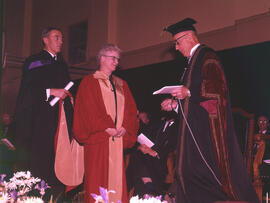
![W.P. Thompson in [Africa]](/uploads/r/university-of-saskatchewan-archives/a/b/0/ab0f69b7c6c41e6b543e3888ab8973c5c4bf0e3893bafb6a10ef38b0bc2c6ccb/A-3367_142.jpg)
